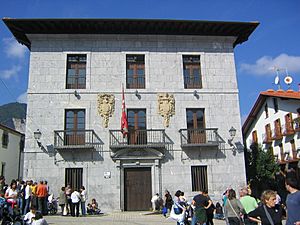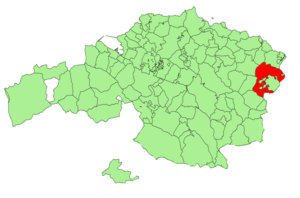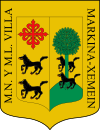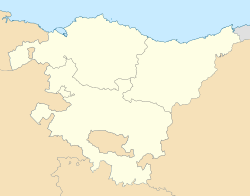Markina-Xemein facts for kids
Quick facts for kids
Markina-Xemein
|
||
|---|---|---|
| Markina-Xemein | ||

Town hall
|
||
|
||
| Motto(s):
Muy Noble y Muy Leal Villa Markina-Xemein
(The very noble and loyal village of Markina-Xemein) |
||

Location of Markina-Xemein in Bizkaia.
|
||
| Country | ||
| Autonomous community | ||
| Province | Biscay | |
| Comarca | Lea-Artibai | |
| Founded | 1952 | |
| Area | ||
| • Total | 44.79 km2 (17.29 sq mi) | |
| Elevation | 85 m (279 ft) | |
| Population
(2018)
|
||
| • Total | 4,934 | |
| • Density | 110.159/km2 (285.31/sq mi) | |
| Demonym(s) | Marquinés/a, Markinarra Jemeindarra, Xemeindarra | |
| Time zone | UTC+1 (CET) | |
| • Summer (DST) | UTC+2 (CEST) | |
| Postal code |
48270
|
|
Markina-Xemein is a town and municipality in northern Spain. It is located in the province of Biscay, which is part of the Basque Country. The town's name comes from its special location. It was the last town in the province of Bizkaia, right on the border with Gipuzkoa. The name "Markina" comes from the Spanish word "marca," meaning "mark" or "border." This area was often where people from Bizkaia and Gipuzkoa met, sometimes even for battles!
The people of Markina-Xemein work in different jobs. Many are involved in farming and raising animals. The town also has a history with the metal industry, even making weapons in the past. A very important part of the local economy is the mining of a special black stone called Nero Marquina (Black Marble). This high-quality stone is famous around the world.
Markina-Xemein is also very famous for Basque pelota, a traditional sport. Its special court, called a frontón, is known as the "University of the Pelota." This is where many great players, especially those who play a fast version called Jai Alai, learned their skills. The town celebrates its main festival in mid-July, honoring the Virgen del Carmen. Throughout the year, Markina-Xemein also hosts many fun fairs and markets.
Contents
Where is Markina-Xemein?
Markina-Xemein is in the northeast part of Biscay, close to the border with Gipuzkoa. The center of the town is quite flat. However, it is surrounded by hills and mountains. Most of these mountains are between 400 and 700 meters high. One of the tallest mountains nearby is Oiz, which is 1,026 meters high.
The main river flowing through Markina-Xemein is the Artibai. It runs from the southwest to the northeast. Near the town center, another river called Urko joins the Artibai.
Markina-Xemein's Weather
Markina-Xemein has a mild climate all year round. This is because it is only about 10 kilometers from the coast. Winters are usually cool and wet, but it rarely snows. Summers can be warm, but temperatures almost never go above 35°C (95°F). All seasons tend to be rainy, with a lot of rainfall throughout the year.
A Look Back in Time
The village of Markina was first founded on May 6, 1355. It was called Villaviciosa de Marquina back then. Don Tello, who was the Lord of Biscay, gave permission for the village to be built. This was done to help local noble families protect the area from attacks by people from Gipuzkoa.
When Markina was founded, it did not have its own church. Instead, people had to use the church in Xemein, which was a separate town at the time. The control of this church caused many arguments between the local noble families, especially during the Middle Ages. Later, on September 29, 1952, Markina and Xemein decided to join together. This is how the town of Markina-Xemein was formed.
The town grew even more in 1969 when Ziortza-Bolibar, a smaller town nearby, also joined. However, this union did not last forever. On January 1, 2005, Ziortza-Bolibar became an independent town again.
Famous People from Markina-Xemein
Markina-Xemein has been home to some notable people:
- Nicolasa Pradera (1870-1959): She was a famous Spanish chef.
- José María Arizmendiarrieta (1915-1976): He was a Catholic priest. He is known for starting the Mondragón cooperative movement, which is a large group of worker-owned businesses.
See also
 In Spanish: Marquina-Jeméin para niños
In Spanish: Marquina-Jeméin para niños




